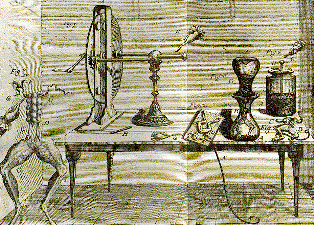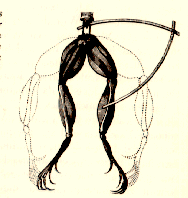Luigi Galvani and the birth of electrobiology
 Luigi Galvani was born in Bologna on September 9, 1737. Outwardly his life was unremarkable. In 1759, he graduated from the University of Bologna (one of the oldest in Europe - he founded in 1119) and stayed in it to work. He was engaged in medicine and anatomy. His thesis was devoted to the structure of bones; In addition, he studied the structure of the kidneys and ear of birds. Galvani received a number of new data, but he did not have to publish them, because a little earlier, most of these facts were described by the Italian scientist A. Scarpa. This first scientific failure did not discourage Galvani.
Luigi Galvani was born in Bologna on September 9, 1737. Outwardly his life was unremarkable. In 1759, he graduated from the University of Bologna (one of the oldest in Europe - he founded in 1119) and stayed in it to work. He was engaged in medicine and anatomy. His thesis was devoted to the structure of bones; In addition, he studied the structure of the kidneys and ear of birds. Galvani received a number of new data, but he did not have to publish them, because a little earlier, most of these facts were described by the Italian scientist A. Scarpa. This first scientific failure did not discourage Galvani.
In 1762, at the age of 25 Galvani began teaching medicine at the University of Bologna, a year later became a professor, and in 1775 - the head of the department of practical anatomy. He was an excellent lecturer, and his lectures were very successful among students. He worked a lot as a surgeon. Medical practice and teaching work took a lot of time, but Galvani, as the true son of his era, did not abandon purely scientific work: both descriptive and especially experimental. Since 1780, Galvani began work on the physiology of nerves and muscles, which brought him worldwide fame and many Troubles.
So, it is understandable why Galvani's doctor made experiments and why he had a frog preparation on his desk. But where does the electric Luigi Galvani machine?

Electricity at this time was considered as an "electrical fluid", as a special electrical fluid. This hypothesis arose after Gray discovered that electricity could "flow" from one body to another if they were connected by metal wire or other conductors.
This hypothesis, of course, was inspired by the ideas prevailing then in other sections of physics. The properties of a weightless fluid-ether-explained the wave propagation of light; Heat was also considered a weightless fluid. The hypothesis of the essence of electricity was subjected to experimental verification.
Electrified bodies were carefully weighed and could not detect weight gain. Thus, the idea of the weightlessness of electric charge was the result not only of speculative reasoning, but also a consequence of insufficient accuracy of measurements.
When it was found out that the electric charge can not be measured by weighing, physicists began to invent fundamentally new devices. These devices - all sorts of electroscopes and electrometers - appear in the middle of the XVIII century. In 1746, the electrometer Ellicotta appeared. In 1747 - the electroscope Nolle, the same abbot who showed the king in Versailles the discharge of the Leyden jar. One of the first electrometers was designed by Richmann.
At first it was believed that the electric fluid is one of the sorts of "heat". This circumstance was justified by the fact that when the body rubs, they heat up and become electrified, and also because an electric spark can ignite different objects. Finally, it was shown that conductors of electricity conduct heat well, and insulators - poorly. However, in the end, it was established that the electric weightless liquid differs from the heat.
First, it was shown that bodies electrified by touch do not heat up.
Secondly, Gray showed that solid and hollow bodies are electrified in exactly the same way, but they heat differently, and concluded that "heat" spreads throughout the body, and the electrical fluid spreads over the surface.
Thus, the idea of electricity as a weightless fluid was experimentally well substantiated at the level of the possibilities of physics of the eighteenth century and fit well with the general ideology of physics of that time.
We have already said that at that time various phenomena, even earthquakes, were tried to explain by electricity, and the "nervous mechanism" was no exception. In 1743 the German scientist Ganzen put forward the hypothesis that the signal in the nerves is of an electrical nature. In 1749, the French doctor Dufay defended his thesis "Is the Nerve Fluid Electric?" The same idea was supported in 1774 by the English scientist Priestley, who was famous for the discovery of oxygen. The idea was clearly in the air.
In connection with these ideas, two areas of experimental research - the study of electricity and the study of processes in the nerves and muscles - have come into contact. There was a hope to establish that processes in the nerves are processes of electrical nature. In addition, electrical discharges were widely used at this time to irritate nerves, skeletal muscles or the heart (for this purpose the Leyden jar was used, for example, by D. Bernoulli and the same F. Fontana, of which we have already spoken).
Now we should not feel strange and accidental that an electric car turned out to be on the table at the doctor Galvani, who was a disciple of Fontana and was engaged in an experimental study of the work of muscles and nerves. It's not that he paid tribute to fashion. The machine was needed because, as now would be said, he worked not just at the forefront of science, but at the intersection of the two sciences: physiology and the science of electricity.

September 26, 1786
After all that has been said, it becomes incomprehensible another thing: what attracted the attention of Assistant Galvani, why the contraction of the muscle in the electric discharge seemed Galvani so remarkable. Because the fact that electricity acts as an irritant on nerves and muscles, was a widely known fact.
The fact is that before Galvani's observations, this irritating effect was observed only when the charged body was directly contacted with a muscle or a nerve. Here such contact was absent.
Faced with a new unfamiliar phenomenon, Galvani, as the true son of his age, begins to thoroughly and comprehensively investigate this phenomenon. He puts a variety of experiences. For example, it shows that the effect is also observed when the frog's foot is placed under the bell of the pump in an airless space, when the Leyden jar is discharged instead of an electric machine.
And even when the frog's foot joins the chain between the lightning rod and the ground, it shrinks at the moment when lightning jumps.
But no matter how interesting these experiments were, they did not give any radically new information about electrical phenomena in living organisms: another form of irritating electricity was discovered, But even physicists knew that bodies can be electrified without touching them, at a distance.
In 1786, Galvani began a new series of experiments, deciding to study the effect on the frog muscles of "calm" atmospheric electricity. (By this time, it was shown that electricity is in the atmosphere and in the absence of a thunderstorm.) Having realized that the frog's foot is in some ways a very sensitive electrometer, he decided to try to detect with its help this atmospheric electricity. Hanging the drug on the grill of his balcony, Galvani waited a long time for the results, but the foot did not shrink under any weather.
And on September 26, 1786, the foot was finally reduced. But this did not happen when the weather changed, but under completely different circumstances: the frog's foot was suspended from the iron lattice of the balcony with a copper hook and with a dangling end accidentally touched the grating, Galvani checked: it turns out that every time a chain of "iron-copper- Foot ", then there is a contraction of the leg muscles regardless of the weather. Galvani transfers experiments to the room, uses different pairs of metals and regularly watches the contraction of the muscles of the frog's foot.

It is already something new, there are no sources of electricity nearby (there is no car, no thunderstorms), and the frog's foot is shortened.
Galvani puts on a beautiful experience in the spirit of his time, when spectacular public demonstrations were very popular. The foot is hung on a copper hook, connected to a silver casket, so that the bottom of the foot touches the casket. The foot is shortened and withdrawn from the casket, from this the chain opens, then the foot falls again, touches the casket, rises again, etc. There is, as Galvani says, something like an electric pendulum. (In fact, this system is completely analogous to a current breaker in an electrical call, but neither current nor a call at that time was yet.)
How can we explain these observations? Since Gilbert's time, it was known that metal can not be electrified by friction. Galvani, like other scientists of his time, believed that electricity can not arise in metals, they can only play the role of conductors. Hence Galvani concludes that the source of electricity in these experiments are the frog tissues themselves, and the metals just close the chain.
But why in this chain need two different metals? Galvani explores this question and discovers that you can do just a piece of copper wire. When using one metal, the reduction does not always occur, it is weaker, but this is a small detail. The contraction of muscles is observed visually, the force of contraction is not measured. It is important that the two metals are not mandatory, and therefore insignificant, - Galvani argues.
 Galvani worked with a neuromuscular drug: the rear foot of a frog with an excised nerve and a preserved piece of the spinal cord. In the first successful experience, when the foot hung on the balcony, the copper hook was passed through a piece of the spine, and the tip of the foot touched the iron grating, Galvani decides that this is the best conditions, and does not try the others.
Galvani worked with a neuromuscular drug: the rear foot of a frog with an excised nerve and a preserved piece of the spinal cord. In the first successful experience, when the foot hung on the balcony, the copper hook was passed through a piece of the spine, and the tip of the foot touched the iron grating, Galvani decides that this is the best conditions, and does not try the others.
In all his experiments, one end of the metal arc touches the spinal cord or nerve, and the second - the surface of the foot. Galvani develops such a scheme: the arm muscle is a charged Leyden jar; Nerve - a wire connected to the inner lining of the can; When the metal conductor touches the muscle (outer lining) and the nerve (internal), the muscle discharges through the nerve and this causes a contraction.
For another four years, Galvani left for a comprehensive study of the open phenomenon, and finally, in 1791, a work appears summarizing the ten-year work - the aforementioned "Treatise on the Power of Electricity in Muscle Motion."
Galvani considers his discovery very important for humanity. The point is that, as we have already said, at this time there were a wide variety of empirical attempts to use electricity for the treatment of diseases, and these attempts had no theoretical basis. Galvani was primarily a doctor and wanted to treat people. He himself writes at the end of his treatise that in the future all his efforts will be directed to the development of a new direction in medicine - electromedicine.
But he was not only a doctor, but also a scientist. He realized that to develop such a direction it was very important to show that electrical phenomena are not something alien to living organisms, that electricity is closely related to life activity, that "animal electricity" by its nature is no different from electricity produced by an electric machine. It is not by chance that Galvani after experiments on frogs puts experiments on warm-blooded animals, showing that the same phenomena can be obtained on neuromuscular preparations of birds and mammals.
Consequently, electrical phenomena are inherent in all animals, and hence man! Galvani even allows himself to comment on the cause of some diseases (for example, he hypothesizes that paralysis can be associated with a violation of the isolation of nerves, and indeed, the diseases caused by this cause are now known, or that epilepsy can be associated with a strong electrical discharge in the brain , Which also proved to be correct in principle) and the possible therapeutic use of electricity.
Putting forth his claim about the existence of "animal electricity", Galvani also relied on the study of electric fishes: in this case their ability to generate electricity was proved. The electric ramp has been known since ancient times, and electric eel was described in the 17th century after the discovery of America. But then, of course, these fish were not called electric, because they did not know that their effect on humans and animals was somehow connected with electricity.
However, after the discovery of the Leyden jar, the discharge of which caused the same effect as the touch of the electric ramp, the French botanist M. Adanson suggested that the discharge of electric fishes and the discharge of the Leyden jar are of the same nature.
Check this hypothesis, the English scientist J. Walsh has shown that the discharge of an electric ray is transmitted through conductors, but not transmitted through insulators and discharges the fish through a chain of several persons (recall the experience of the abbot Nollet!), Ie, received arguments in favor of electric Nature of this category. At first, Walsh observed the discharge of the ramp through a strip of foil glued to the glass with a thin cut; At each discharge in the place of the cut a spark jumped. In 1776 G. Cavendish, attaching the conductors to the back and belly of the stingray, measured the charge created by him with the help of an elderly electroscope.
With electric slopes worked and Galvani, one of the species of these fish even bears his name: Torpedo Galvani. If the rays can produce electricity, then why can not they produce any muscle? And Galvani emphasizes in his "Treatise ..." the similarity of electricity arising from friction, atmospheric electricity, the electricity of skates and the "animal electricity" that he discovered.
It is very interesting that, despite the rather convincing data that the action of the ramp is associated with an electric discharge, there were many people who believed that "animal electricity" should be different from ordinary electricity, should have some signs of its own special origin.
On this point of view was, in particular, J. Priestley, and more than half a century later - G, Devi. This circumstance prompted M. Faraday to undertake in 1837-1839 gg. A series of special works in which he showed that electricity from friction, electricity from the galvanic cells, at this time already known, and the electricity of the fish are no different from each other. The great authority of Faraday contributed to the common recognition of the identity of the "animal" and ordinary electricity.
Berkinblit MB, Glagoleva Ye. G. "Electricity in living organisms"


Comments
Commenting on, remember that the content and tone of your message can hurt the feelings of real people, show respect and tolerance to your interlocutors even if you do not share their opinion, your behavior in the conditions of freedom of expression and anonymity provided by the Internet, changes Not only virtual, but also the real world. All comments are hidden from the index, spam is controlled.